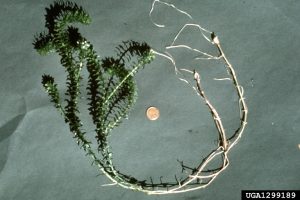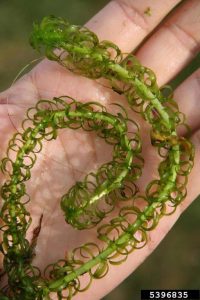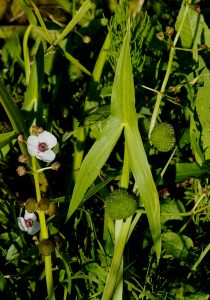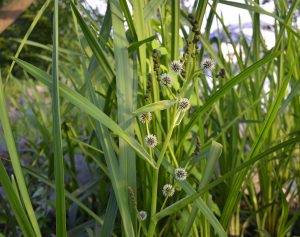Aquatic weeds are of particular concern for invasion because they can be more difficult to manage, and in some cases more quickly and dramatically impact ecosystems and resources such as salmon. Water also acts to mediate climatic conditions for plants which makes aquatic species from more temperate areas more likely than terrestrial plants to establish and thrive in the subarctic regions of Alaska. Aquatic invasive plants are sometimes when introduced into artificial ponds and aquaria and later are dumped or otherwise spread from those introductions. Tips on keeping ponds and aquaria without invasive plants are found here: http://www.nonnativespecies.org/downloadDocument.cfm?id=416.
Hydrilla verticillata, Hydrilla
General Description
Hyrdrilla is one of the more troublesome aquatic invasive plants that are established in waterbodies of the United States. Hydrilla grows in virtually any waterbody from shallow to deep freshwater, and will tolerate saline environments as well. Hydrilla first occurred in southern states, but has since spread north with some infestations found in the state of Washingtion. Hydrilla is able to withstand unfavorable conditions by going dormant using organs called turions to regenerate. The turions are formed at the leaf axil and the branch tips that grow into soil. The turions store food material, and may become detached from the mother plant to form new plants.
Identification
Hydrilla is a submerged perennial plant that only comes above the surface when flowering (Figure 20). The stems are branched, 1mm thick and 3 m (10 feet) long (Figure 21). Leave are in whorls (circle around the stem at a single point or node) with three to eight sometimes more leaves in a whorl (Figure 22). The leaves are 7-40 mm (3/4-1.5 inches) long, linear and have a midrib. Flowers are small, and may be used for identification by trained botanists. For the purposes of early detection and reporting leaf shape characteristics are more than adequate.
Leaf characteristics are used to distinguish Hydrilla from other non-native and invasive plants. Elodea canadensis and nutallii have similar leaf characteristics to Hydrilla, however Elodea species have whorls of three leaves while Hydrilla has whorls of 4-8 leaves.
Few native species may be mistaken for Hydrilla given the leaf characteristics and growth habits. One exceptions is Mare’s tail (Hippuris spp.). Mares tail has whorls of 4-12 leaves and has bottle brush like spikes that emerge above the surface of the water in summer. Hydrilla only grows above the surface when flowering.
More information on identification of Hydrilla is found here (http://plants.ifas.ufl.edu/plant-directory/hydrilla-verticillata/).
Impact and spread
Hydrilla has been sold as an aquarium plant, and may still find it’s way inadvertently into the pet trade despite being a federal listed noxious weed. Once established Hydrilla’s rapid growth forms dense mats of vegetation that outcompete native plants, change ecosystem dynamics, and interfere with uses recreational uses of waterways such as boating, swimming, and fishing. Hydrilla reproduces with stem fragments, turions, roots, and seed. Any broken part of the plant can act as a new source infestation, and thus established populations are spread by waterfowl, flowing water, float planes, and boats.
Management
Manual management isn’t likely to work unless the population is small and confined. Similar specie in Alaska, such as Elodea, are not managed effectively with manual treatments including pulling or dredging, and those treatments are extremely expensive. Chemical treatments may be effective, and have proven extremely effective with Elodea species.
Where to look
Lakes, ponds, sloughs, slow moving water bodies are typical places where Hydrilla may be found. Given past introductions in Alaska of Elodea, a similar aquatic weed that is common in the aquarium trade, Hydrilla may be first introduced in locations where a person may have dumped their aquaria. Thus, be suspicious of plants resembling Hydrilla at water bodies that are near residential areas and schools. Lakes accessed by floatplanes, and popular with boating, particularly by boats that may have originated from outside Alaska are also places where Hydrilla is likely to be introduced to Alaska. Suitable climates for Hydrilla exist in all regions of Alaska.
Other resources:
- https://www.invasivespeciesinfo.gov/aquatics/hydrilla.shtml
- http://www.sms.si.edu/irlspec/hydrilla_verticillata.htm
- https://nas.er.usgs.gov/queries/FactSheet.aspx?speciesID=6
- http://www.cabi.org/isc/datasheet/28170
Lagarosiphon major, Oxygen weed
General Description
Oxygen weed is native to freshwaters in tropical parts of Africa, however, could also be problematic in waterbodies of North America. Oxygen weed is a popular aquarium plant, and despite being a federal listed noxious weed may still be purchased online through the global market. Oxygen weed spreads by roots and vegetative fragments that break off the plant and float to new areas. The rapid growth of Oxygen weed, has allowed it to become a dominant plant species, in a short period after introduction, leading to significant changes to ecosystem function.
Identification
Oxygen weed is a perennial submerged aquatic plant with brittle stems that grow up to 6 meters (20 feet) long, 3-5 mm (1/10-1/5 inches) in diameter, with a distinctive J curve at the base (Figure 23). Leaves are alternately spiraled, and become close together towards the tip of the plant (Figure 24 and 25). Leaves are 5-20 mm (1/5-4/5 inches) long, 2-3 mm (~1/10 inch) wide, and have small teeth. The tips of the leaves are tapered and curve down towards the stem. Plants are dioecieous, and flowers are minute. Only the female plant is known outside of its native range.
Elodea species, and Hyrdilla may be mistaken for oxygen weed. Elodea is present in Alaska, however we need reports from any of these weeds so do not refrain from reporting if you are unsure of the exact species. Oxygen weed is distinguished from Elodea and Hydrilla because the leaves of oxygen weed are spiraled around the stem in an opposite configuration while the leaves of Hydrilla and Elodea are whorled.
Mare’s tail (Hippuris spp.) may be confused with oxygen weed, but mares tail has whorls of 4-12 leaves and has bottle brush like spikes that emerge above the surface of the water in summer.
Impact and spread
Oxygen weed grows rapidly and spreads by roots and broken fragments of stems. Once established the rapid growth causes it to crowd out native vegetation, leading to changes in ecosystem function. The growth of oxygen weed can clog public facilities such as dams and canals, and impede the use of watercraft. Oxygen weed is used in the aquaria trade to add oxygen to the water, however, in its introduced range the large amount of biomass created tends to decrease oxygen levels in water when plant parts begin to decompose.
Management
Oxygen weed infestations are easiest to control if they are in the early stages. Physical controls such as mowing or cutting will not work because they create plant fragments that may spread to form new infestations. Pulling, digging, and suction dredging in attempts to remove all plant parts including the roots are not likely to be successful. Some chemical controls have been found effective on oxygen weed.
Where to look
Oxygen weed grows in silty and sandy sediments in clear water lakes, ponds, reservoirs, slow moving rivers, canals and drainage ditches. Given past introductions in Alaska of Elodea, a similar aquatic weed that is common in the aquarium trade, oxygen weed may be first introduced in locations where a person may have dumped their aquaria. Thus, be suspicious of plants resembling oxygen weed at water bodies that are near residential areas and schools. Lakes accessed by floatplanes, and popular with boating, particularly by boats that may have originated from outside Alaska are also places where oxygen weed is likely to be introduced to Alaska. Suitable climates in Alaska for oxygen weed are in Southeast Alaska.
Other resources:
- https://www.environment.gov.au/biodiversity/invasive/weeds/publications/guidelines/alert/pubs/l-major.pdf
- http://dnr.wi.gov/files/PDF/pubs/ss/SS1050.pdf
- http://www.iucngisd.org/gisd/species.php?sc=403
- http://www.aquaticplantcentral.com/forumapc/plantfinder/details.php?id=127 https://plants.ifas.ufl.edu/plant-directory/lagarosiphon
- major/ https://plants.usda.gov/core/profile?symbol=LAMA15
Sagittaria sagittifolia, arrowhead
General Description
Native to Asia and Europe, Arrowhead is a highly adaptable aquatic plant that grows in a variety of conditions including persisting in dry ground. The tubers have been cultivated for human consumption in some places. The species is problematic for crop irrigation systems. Alaska has a native species of arrowhead, Sagittaria cuneate that grows along shorelines, and also has edible tubers. The worldwide distribution of arrowhead spans tropical to sub-arctic regions, and it has been reported in parts of North America.
Identification
Arrowhead is a perennial aquatic herb with leaves that are narrow and triangular similar to a spearhead, and the petioles are triangular (Figure 26). The leaves will stand above the waters surface (Figure 27). Early in the season leaves may be submerged and ribbon-like. The flowers of arrowhead are white with three petals and a purple spot at their base (Figure 28). Flowers are grouped in threes at each node forming a whorl. Differentiating arrowhead from the native species arumleaf arrowhead (Sagittaria cuneate) is difficult. However arumleaf arrowhead does not have a purple spot at the base of the flower.
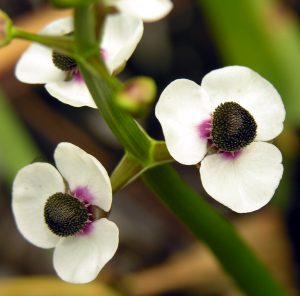
Impact and spread
Arrowhead spreads through seed, movement of whole plants, and when tubers break off the parent plant. Seeds float allowing it to be carried on currents. Where it is introduced it presents problems for irrigation systems and canals.
Management
Arrowhead may be controlled with hand pulling or digging if all the tubers are removed.
Where to look
Arrowhead is most likely to be introduced into lakes, ponds, water gardens, or other landscaped water catchments. Suitable climates in Alaska for arrowhead exist in Southcentral Alaska.
Other resources:
- http://dnr.wi.gov/topic/Invasives/fact/HawaiiArrowhead.html Wisconsin
- http://www.invasiveplantatlas.org/subject.html?sub=4541
- https://www.youtube.com/watch?v=QC5Pu9E5ZUs Random youtube video no talking
- http://www.iucngisd.org/gisd/species.php?sc=858 Global invasive species database
- http://www.cabi.org/isc/datasheet/109160
Sparganium erectum, exotic bur-reed
General Description
Grows rooted in the mud at the margin of waterbodies and as an emergent plant near shores. The plant is perennial. It is introduced in California, and Canada.
Identification
Leaves are erect, narrow, triangular in cross section, and have a smooth keel (Figure 29). Flowers are spherical, on branches. Male flowers at the end of the branches are round and dark green to black, while female flowers are further down the branch and resemble a bur particularly before and as they form fruit (Figure 30 and 31). Each fruit contains 2 seeds. Exotic bur-reed looks similar to a native northern bur-reed (Sparganium hyperboreum) however the exotic bur-reed has erect leaves while the norther bur-reed has limp leaves. Exotic bur-reed can also be substantially taller reaching nearly 2 meters (6.5 feet) tall while northern bur-reed only reaches 1 meter (3.25 feet) in length.
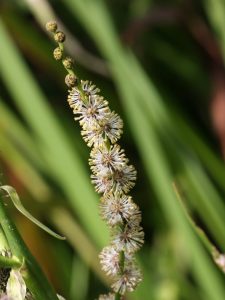
Impact and spread
Exotic bur-reed spreads by seed as well as rhizomes. Seeds will float for long periods of time. No information is available on impacts.
Management
Little information is available on management. Cattle graze on this species, and in introduced areas it is not found where cattle are allowed to graze.
Where to look
Exotic bur reed can be found on freshwater margins. It may be introduced in rain gardens or other water features, or high traffic areas for float planes and boats. Suitable climates in Alaska for exotic bur reed exist on the Kenai and Alaska Peninsulas, and the Pribilof Islands.
Other resources:
- http://www.arkive.org/branched-bur-reed/sparganium-erectum/
- http://www.invasiveplantatlas.org/subject.html?sub=4575
- http://www.naturespot.org.uk/species/branched-bur-reed
- https://plants.usda.gov/core/profile?symbol=SPER


